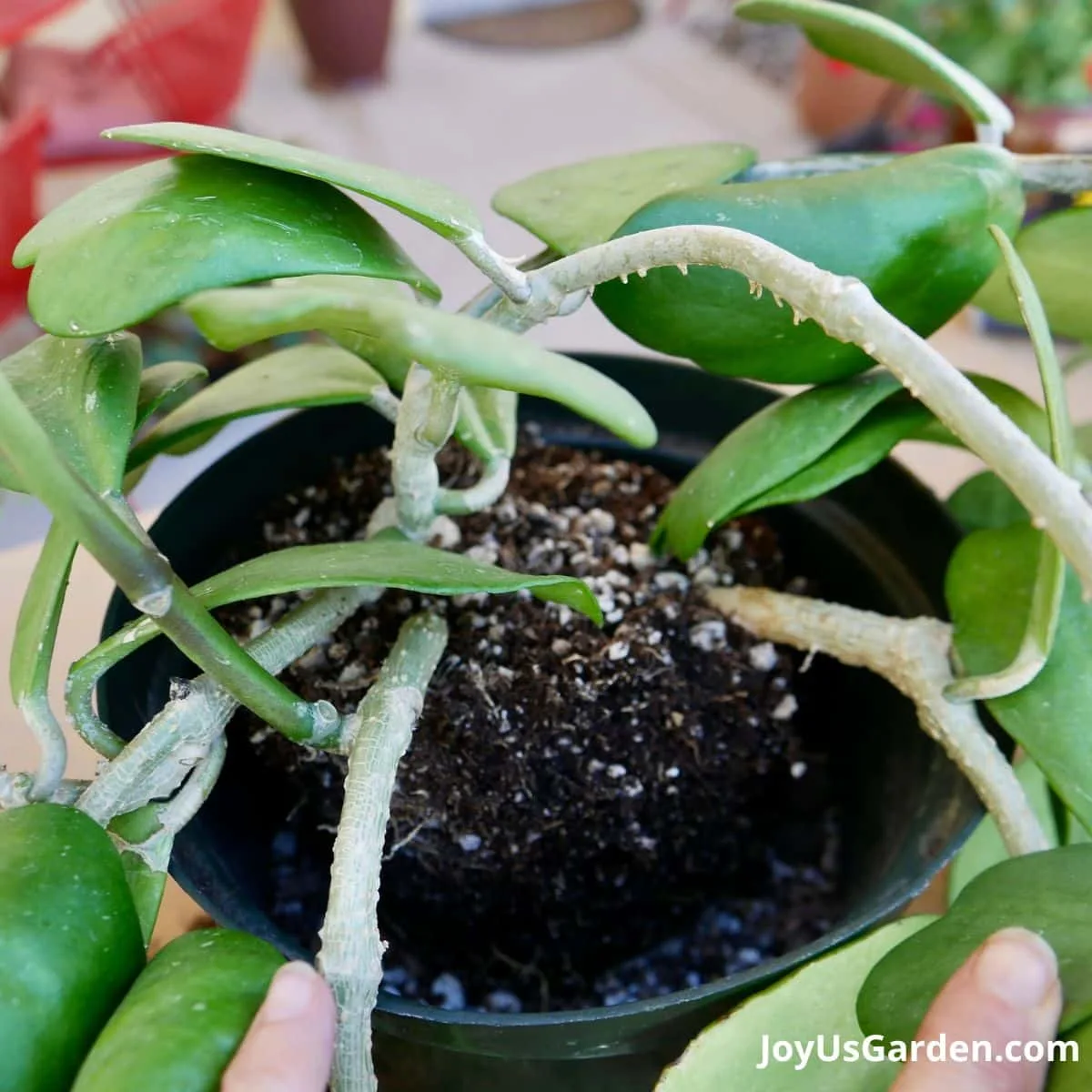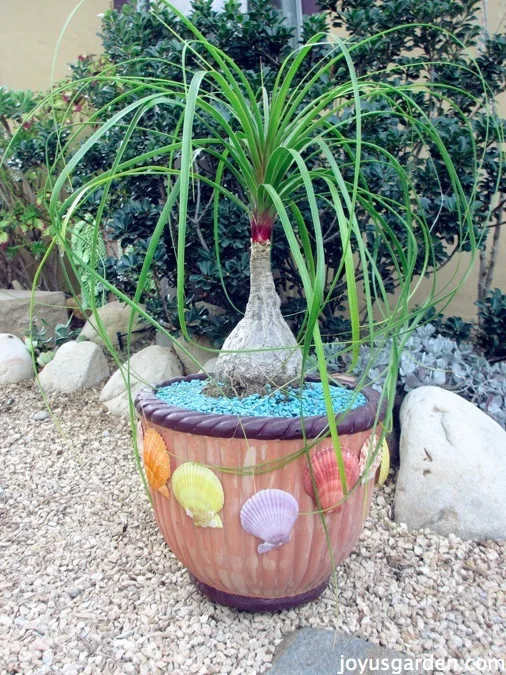Repotting Hoya Kerrii Guide + The Soil Mix To Use
This guide outlines Hoya Kerrii repotting, including when to do it, the soil mix to use, steps to take, the aftercare, and other good things to know.
Hoyas are durable, easy-care, and attractive hanging indoor plants. Perhaps you know Hoyas as Wax Plants because of their waxy leaves and flowers. They look great in a hanging basket which is what a couple of mines are growing in. I have one growing on bamboo hoops.
We love them here at Joy Us garden. Even though they have a somewhat shallow root system, yours will need a new pot at some point.
I want to share common names a Hoya Kerri goes by, and there are quite a few. You may know it as Sweetheart Hoya, Sweetheart Plant, Hoya Heart, Heart Hoya Plant, Valentine’s Hoya, Heart-Shaped Hoya, Wax Heart Plant, Hoya Sweetheart Plant, Love Heart Plant, Valentine Hoya, or Lucky Heart Plant. They’re very popular come Valentine’s Day when sold as single-leaf plants!
Reasons To Repot Hoya Kerrii

There are a few reasons to repot a plant. Here are a few: the roots are coming out the bottom, the roots have cracked the pot, the soil is getting old, the plant is out of scale with the pot, and the plant is looking stressed.
I repotted mine because the plant wasn’t growing evenly round. It was front-heavy, tilting, and wouldn’t stand up on its own.
It was flipping forward because of the unbalanced weight and I had anchored it upright with a rock in the back of the pot.
Hoya Kerriis, unlike other Hoyas, have big thick leaves and fat stems making them quite heavy. The roots weren’t coming out of the drainage holes but the plant had fallen over a few times (enter the balancing rock) and I wanted to fix that. It was time to give the plant a bigger base.
If you’re new to houseplant gardening, check out our Guide To Repotting Plants. It gives you all the basics.
Best Times to Repot Hoya Kerrii
The best time for repotting this plant is in spring and summer. Early fall is fine too if you’re in a more temperate climate like the one I live in here in Tucson, Arizona.
If you have to repot in the winter months, no worries. Just know it isn’t optimum.

Pot Size
In their native environments, most hoya plants are epiphytes, which means they grow on other plants. Their roots are mainly an anchoring mechanism.
Sweetheart Hoyas are commonly sold in 4″ and 6″ grow pots. I bought mine in a 6″ pot with a hanger.
My Sweetheart Hoya plant was flipping forward because of the unbalanced weight so I moved it up from a 6” pot into an 8” so it has a bigger base.
The general rule is to go up one pot size as the roots of a Hoya aren’t too extensive.
This isn’t related to size, but having drainage holes in the bottom of the pot is best so the excess water can freely flow out.

How Often To Repot
I got this as a 6″ plant, so it is now in need of a bigger pot.
Most hoya plants are epiphytes, and their stems will put out aerial roots and which enables them to grow up other plants. Their roots are just for anchoring.
Don’t think your Hoya Kerrii will need it every year for transplanting and repotting. Like Orchids, they’ll bloom better if slightly tight in their pots so leave them be for a few years. In general, I repot mine every 4 or 5 years.
Soil Options
In nature, plant matter from above falls on the Hoyas growing below. These tropical plants love a rich mix that gives excellent drainage and has some wood, like coco chips or orchid bark.
I used ½ potting soil mixed with ½ DIY Cactus and Succulent Mix.
For this project, I used a 1:1 mixture of Ocean Forest and Happy Frog potting soils. Sometimes I use them separately, and sometimes I mix them together.
The DIY cactus and succulent mix have a lot of cocoa chips and coco fiber in it and blending it in with the potting soils makes a Hoya very happy.
I mixed in a few handfuls of compost/worm compost as I planted and topped it all with a ¼” layer of the compost on top.
This mix is rich but yields good drainage, and the water will flow right through and out the drain holes preventing root rot.
You’ll find more straightforward mix blends below.

Soil Mix Alternatives
I know many of you live in urban areas and have limited storage space. I know, it was the same for me for many years.
I now have 1 bay of my garage dedicated to my plant addiction. It gives me a place to store all my materials. I have at least 10 components on hand ready to go for whatever I’m planting or repotting.
Using good potting soil is fine but it’s better to lighten it up as Hoyas don’t like to stay wet. Loose soil that’s aerated is what they want.
Any of these will work too:
- 1/2 potting soil, 1/2 fine orchid bark
- 1/2 potting soil, 1/2 coco coir
- 1/2 potting soil, 1/2 pumice or perlite
- 1/3 potting soil, 1/3 pumice or perlite, 1/3 coco coir
Hoya Kerrii Plant Video Repotting Guide
Let me show you the repotting method for the Sweetheart Hoya or Hoya Kerrii:
Steps To Repotting
It’s best to watch the video, but here’s the breakdown of what I did:
First thing, I watered the Hoya 2-3 days before this project. A dry plant is stressed, so I ensure my indoor plants are watered 2- 4 days in advance. I find that if I water the day of, the soggy soil can make the process a bit more messy than it already is.
This plant doesn’t have a huge root system so I’m just going to go up to an eight-inch nursery pot.
Put a layer of newspaper in the bottom of the pot if it has a lot of drain holes. I poked tiny holes in the newspaper with the tip of my floral snips. Eventually, the newspaper will disintegrate, but for now, it will help keep the soil mix inside the pot for the first few waterings.
Optional: You may need to prune the plant first especially if it has stems growing loose. Mine had a lot of wacky end growth. As I said above, Hoyas are vining in nature.
Note: A Hoya Kerri is typically a slow grower. Succulent-like leaves will eventually appear on those long stems (you’ll see them in the beginning of the video), but mine was just taking up too much space so I pruned a few of them back a bit.
Note: Hoyas do emit a sap, but it is non-toxic and may only cause minor skin irritation.
I was careful when removing the rootball from the pot because they’re typically small. The root ball stayed intact, and I gently massaged it a bit because it’s the best way of loosening and giving it a head start on growing.
I put enough soil mix in the bottom of the pot to raise the root ball up, so it sits just below the top of the pot.
For this project, I put the root ball against the back of the pot (for balancing) rather than in the middle of the pot. You may not need to do this, so put the root ball in the middle of the pot as you normally would if that’s the case.
I filled in around the front of the rootball with the potting mix and add in a couple of handfuls of compost/worm compost.
I put a bit more of the mix to level it off.
Hoyas love a rich mix, so I topped it all with a ½” layer of compost/worm compost on the top.
Success! The plant stands up beautifully on its own now, and the rock anchoring it down is back out in the garden.

How Often To Repot Sweetheart Hoya
Most Hoya plants are epiphytes, which means they grow on other plants. Their roots are mainly for anchoring, so they don’t fast outgrow their pots.
Don’t think your Hoya Kerrii will need it every year for transplanting and repotting. Like Orchids, they can stay in their pot for a while but will bloom better and do better if slightly tight in their pots. Leave them be until they need it.
I repot mine every 4 or 5 years if only to refresh the soil mix.
I got this Hoya in a 6” grow pot, and it needed a larger pot (8″) to balance out the weight.
Some Of Our General Houseplant Guides For Your Reference: Guide To Watering Indoor Plants, Beginner’s Guide To Repotting Plants, How to Clean Houseplants, Winter Houseplant Care Guide, Plant Humidity: How I Increase Humidity For Houseplants, Buying Houseplants: 14 Tips For Indoor Gardening Newbies
Hoya Kerrii Care After Repotting
I watered it thoroughly while still outside (I did this repotting project on my back patio) and let all the water drain out the bottom of the pot.
I waited about half an hour and then put it back in the spot with bright, indirect light in my kitchen where it had been growing. I keep it in bright light but out of direct sunlight as this will cause sunburn, especially here in the desert!
I’ll resume the regular watering schedule once the soil is almost completely dry. Because they store water in their stems and fleshy leaves, watering too often will “mush” them out.
Caring for this plant is easy. Here’s much more on Hoya Kerri Care. This is a general guide to Growing Hoya Houseplants.

How The Hoya Is Doing Now
I’m writing this post 3 months after I did the repotting and filmed the video. The Hoya is nice and green (I’ve fed it a couple of times since), is putting out some new growth, and looks good. Most importantly, it doesn’t lean forward and can stand up on its own!
I live in the Sonoran Desert where all of my 5 Hoyas do well despite the dry air and heat. There are also variegated forms of this Sweetheart Plant if that’s a look you like.
Hoya Kerriis are easy to repot and make beautiful houseplants. I hope this has helped you out, especially if you’re new to repotting.
Happy gardening,

This post may contain affiliate links, you can read our policies here.





